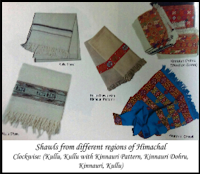Working on Himalayan Textiles by Vedant Chandel
 Having had more than 2 months off of SA, it was time to get back to work. And, what better way of doing it than working on a topic that relates to you and your region, and with a partner you are more than happy to work with(yes, I do mean Rakshanda Thakur!). So, we started to work with a rather uncharacteristic way, before time. Most of the early work involved discussions that were more familiar situations on not talking about actual work.
Having had more than 2 months off of SA, it was time to get back to work. And, what better way of doing it than working on a topic that relates to you and your region, and with a partner you are more than happy to work with(yes, I do mean Rakshanda Thakur!). So, we started to work with a rather uncharacteristic way, before time. Most of the early work involved discussions that were more familiar situations on not talking about actual work.
Time went by, it was the final day before submission. We had read all that we could, went to museums and handloom stores, met with people, interviewed them, shared our findings, so it was finally time to ask Shriya to repeat the briefing she gave us at the start of the task! Finally, after the much needed push from her began the writing part.
 Work was divided as it usually is by this stage in a task, it was time to translate our knowledge into words. With a partner who is as comfortable and familiar with a topic as mine was, and the work experience that we had shared, and the deadline approaching, we were in our comfort zone. Sections were written, partner work was read (and admired), things were added last minute, and by things we mean entire sections, interviews from family members who were surprise carriers of the knowledge for the craft of textile weaving, Shriya was consulted every hour and in no time, it was time.
Work was divided as it usually is by this stage in a task, it was time to translate our knowledge into words. With a partner who is as comfortable and familiar with a topic as mine was, and the work experience that we had shared, and the deadline approaching, we were in our comfort zone. Sections were written, partner work was read (and admired), things were added last minute, and by things we mean entire sections, interviews from family members who were surprise carriers of the knowledge for the craft of textile weaving, Shriya was consulted every hour and in no time, it was time.  The work that went into the task was of greater depth that I had put into any other task so far. Thanks to really wonderful people who we came across at the Himachal Emporium in Shimla, capital city of Himachal Pradesh who were all in for every bit of help that they could offer new dimensions of research work were discovered. My partner who had the practical knowledge of all that we worked on was an even greater asset. Family history was unraveled, and stories that had never been were noted. All of that, added to the affinity that we developed for not just the essay, the topic, the people associated, and most importantly to the art made it the most awarding experience yet.
The work that went into the task was of greater depth that I had put into any other task so far. Thanks to really wonderful people who we came across at the Himachal Emporium in Shimla, capital city of Himachal Pradesh who were all in for every bit of help that they could offer new dimensions of research work were discovered. My partner who had the practical knowledge of all that we worked on was an even greater asset. Family history was unraveled, and stories that had never been were noted. All of that, added to the affinity that we developed for not just the essay, the topic, the people associated, and most importantly to the art made it the most awarding experience yet.


Comments
Post a Comment